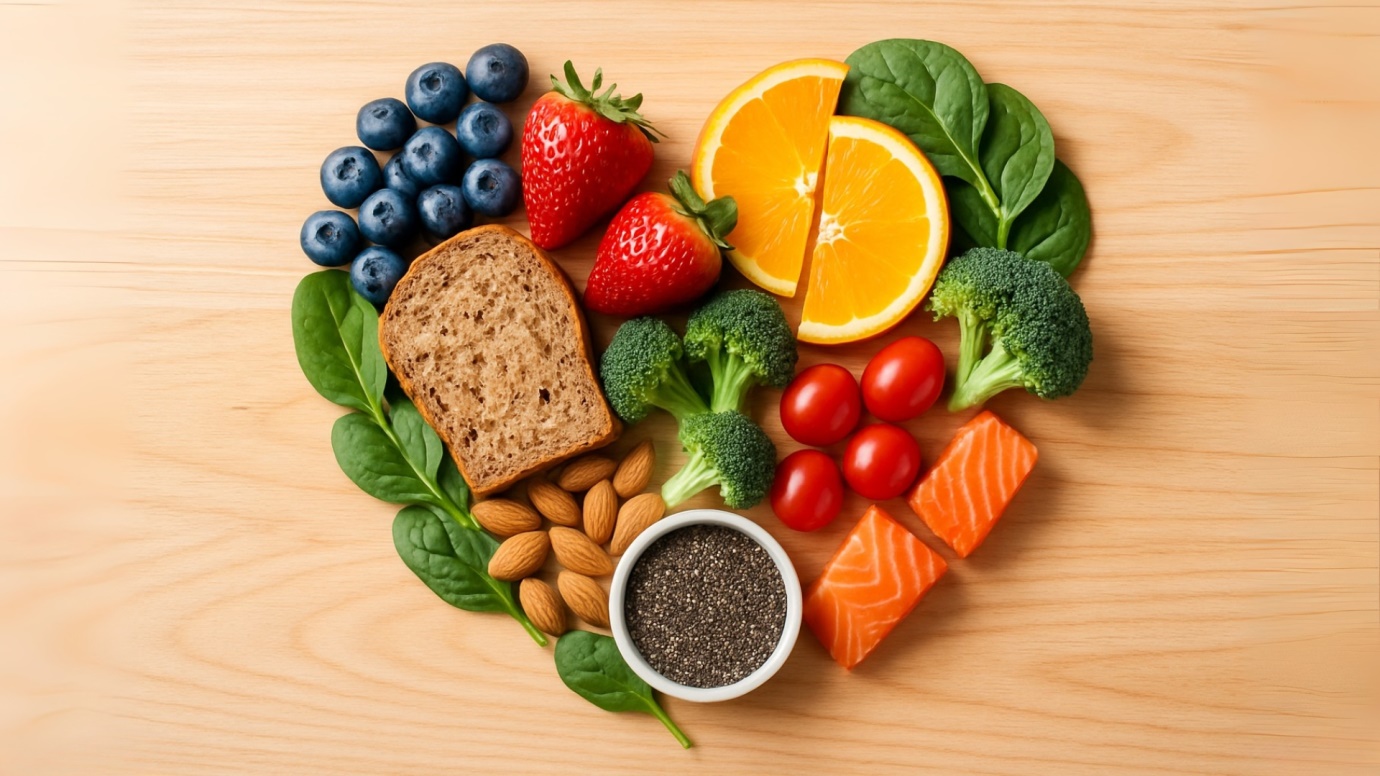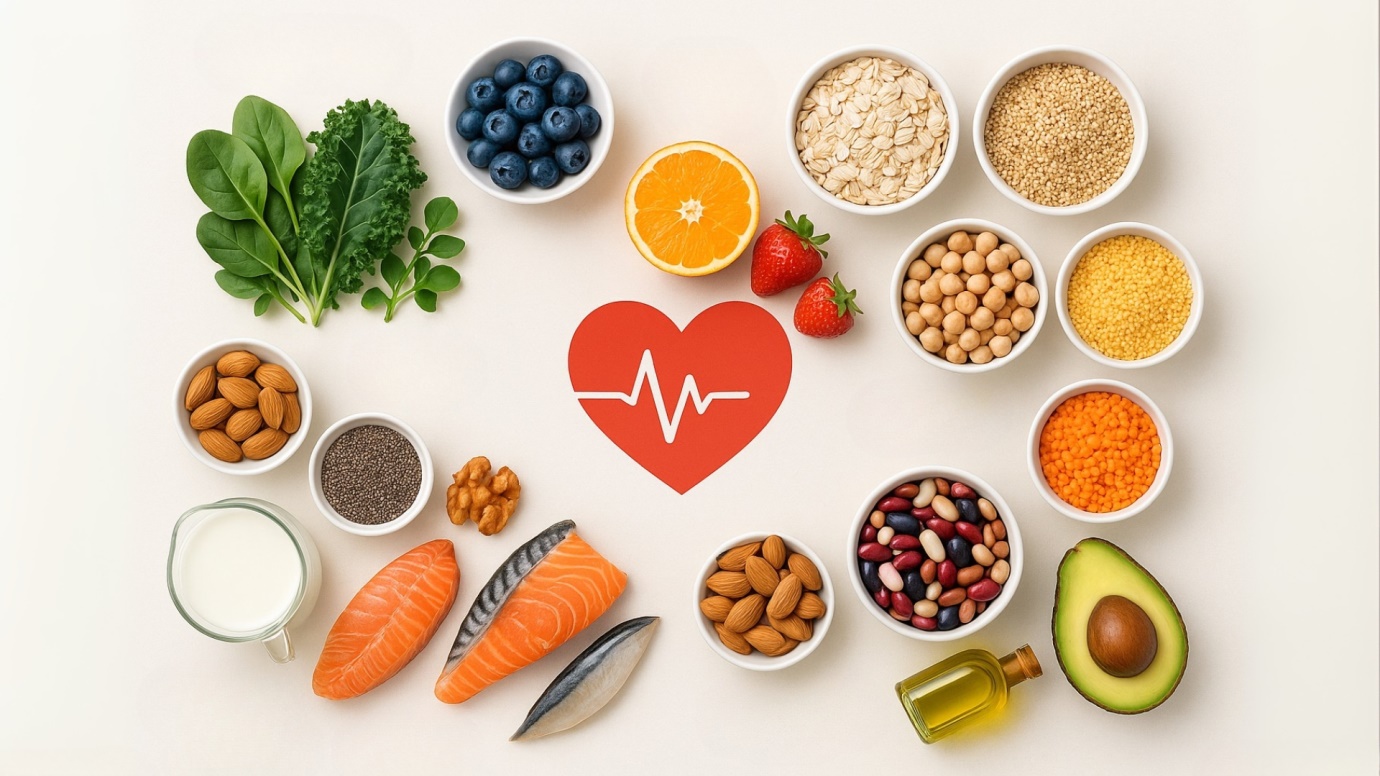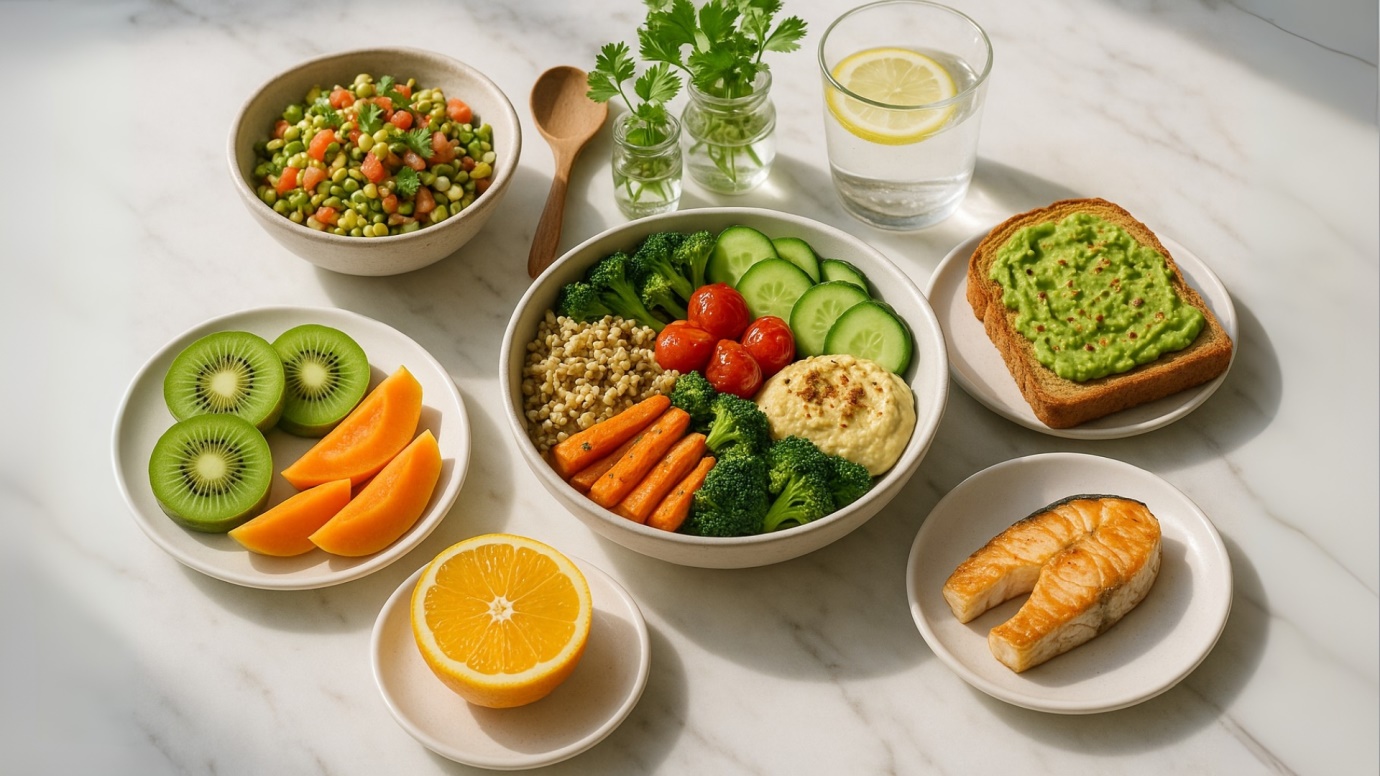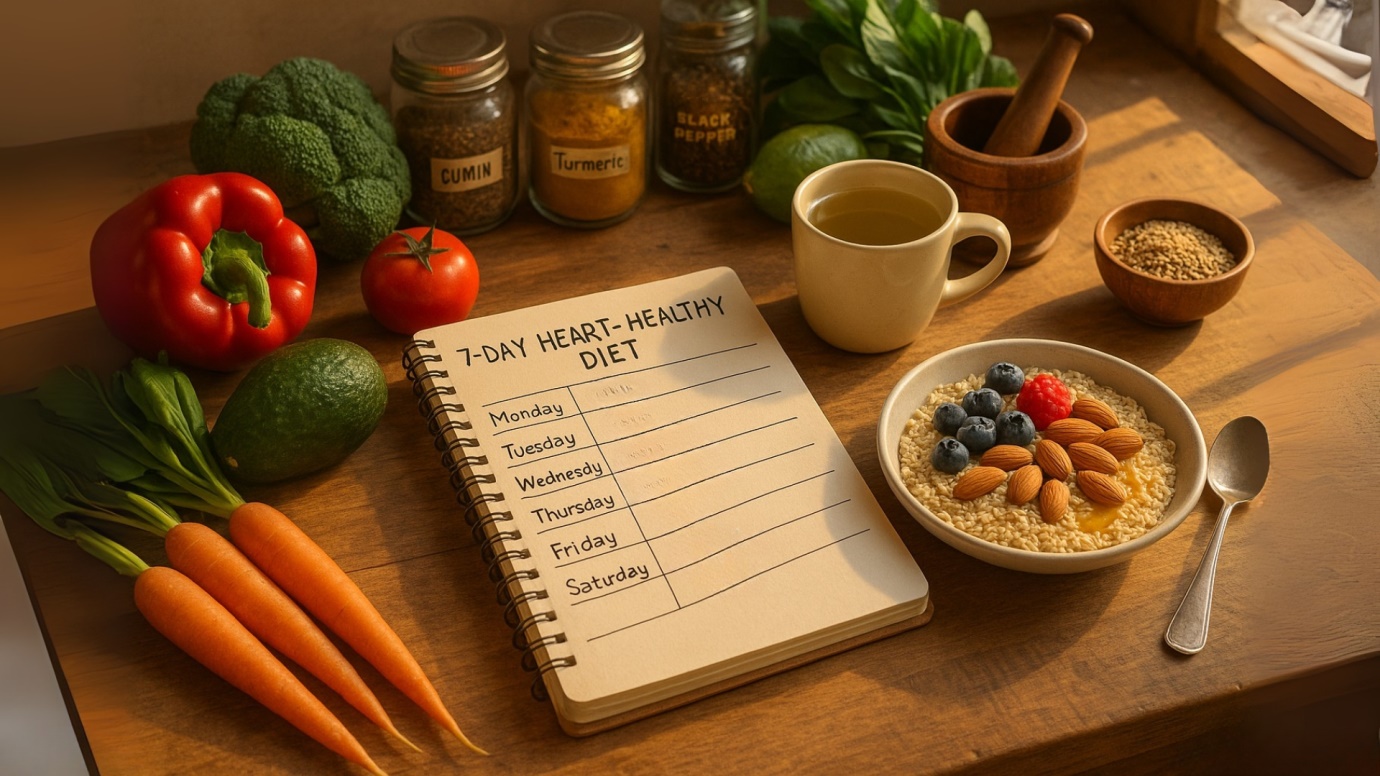Heart disease remains one of the world’s leading causes of death—but a large share of risk is preventable with everyday choices, especially what’s on your plate. A heart healthy diet isn’t a short-term fix; it’s a sustainable way of eating that lowers blood pressure, improves cholesterol, and calms inflammation. In simple terms, a healthy diet for healthy heart means more whole foods (vegetables, fruits, legumes, whole grains, nuts, seeds, and fish) and fewer ultra-processed, salty, and sugary options.
A “good heart” truly starts in the kitchen. The meals you cook can either stress your arteries or support them. Choosing a diet for good heart means favoring fiber-rich staples, smart fats (like olive oil and omega-3s), and mindful portions—without relying on added salt for flavor. Think of this approach as a heart friendly diet that fits real life: flavourful spices, colorful produce, and satisfying proteins you can enjoy every day. If you’ve been searching for a practical good heart diet, you’re in the right place.
This blog brings it all together. You’ll get science-backed guidance on what to eat and why, simple shopping and cooking tips you can actually use, and a ready-to-follow 7-day meal plan to make a diet for good heart effortless from breakfast to dinner. Whether you’re just starting with a heart healthy diet or refining your routine for a healthy diet for healthy heart, our goal is to give you clear steps that protect your heart—without sacrificing taste.

Why Diet Matters for Your Heart
What you put on your plate shapes cholesterol levels, blood pressure, inflammation, and the resilience of your blood vessels. A thoughtfully planned diet and heart disease strategy lowers LDL (“bad”) cholesterol, supports flexible arteries, and steadies blood pressure—key reasons every cardiology guideline emphasizes food first. If you’ve been searching for a practical diet for heart disease or a sustainable diet for heart problems, know that nutrition isn’t a side note; it’s frontline therapy.
How Food Choices Change Risk Factors
Cholesterol:
Soluble-fiber foods (oats, beans, lentils, psyllium, barley) trap cholesterol in the gut and help lower LDL. Replacing saturated fat (fatty red meats, butter) with unsaturated fats (olive oil, nuts, seeds, fish) improves your lipid profile—an essential pillar of any cardiac health diet.
Blood Pressure:
A lower-sodium pattern with plenty of potassium-rich produce helps relax blood vessels and reduce fluid retention. That’s why a well-built cardio health diet leans hard on vegetables, fruits, and minimally processed foods.
Inflammation & Vessel Health:
Antioxidant- and polyphenol-rich foods (berries, greens, olive oil, herbs/spices) calm inflammation and protect the endothelium (your vessels’ inner lining). This is exactly what a cardiac healthy diet aims to do—feed your arteries, not just your appetite.
What the Research Says: Mediterranean & DASH
Decades of research link the Mediterranean Diet to lower cardiovascular risk. It centers on plants, extra-virgin olive oil, nuts, legumes, whole grains, and fish—an ideal blueprint for a cardiac friendly diet that’s satisfying and realistic.
The DASH Diet (Dietary Approaches to Stop Hypertension) is clinically proven to reduce blood pressure by emphasizing vegetables, fruits, low-fat dairy, legumes, whole grains, and lean proteins, while limiting sodium and sugary, ultra-processed foods—core principles for any cardiac disease diet designed to prevent events and support long-term heart health.
Nutrients That Move the Needle
Saturated Fats:
Limit saturated fat (and avoid trans fats). Swap ghee/butter and fatty cuts for olive oil, nuts, seeds, and fish. This shift is central to a results-driven diet and heart disease
Sodium:
Keep sodium low by cooking at home, flavoring with lemon, herbs, garlic, and spices, and reading labels. This is a cornerstone of a practical diet for heart disease that controls blood pressure without sacrificing taste.
Fiber:
Aim for 25–30 g/day, especially soluble fiber from oats, legumes, and fruits. High-fiber meals are non-negotiable in a diet for heart problems because they help lower LDL and improve satiety.
Omega-3s:
Fatty fish (salmon, sardines, mackerel) and plant ALA sources (flax, chia, walnuts) support triglyceride control and reduce inflammation—perfect fits for a cardiac health diet and cardio health diet
Build each plate around vegetables and whole grains, add legumes or lean proteins, include healthy fats, and keep salt in check. That’s the essence of a realistic cardiac healthy diet—a cardiac friendly diet you can maintain for life. Whether you follow a Mediterranean pattern, DASH, or an Indian-adapted hybrid, the goal is the same: a flexible cardiac disease diet that protects your heart meal after meal.
Key Principles of a Heart-Healthy Diet
A smart plate—not a strict fad—is what powers a cardiac diet. These principles help you build a sustainable heart healthy diet that lowers risk, fits your culture and routine, and actually tastes good. If you’re putting together a heart patient diet plan or a practical diet plan for heart patients, the steps below are your everyday playbook for a truly heart friendly diet and long-term diet for good heart results.

1) Limit Unhealthy Fats
Cut back on butter, ghee, cream, fatty red meats, processed meats, and anything with “partially hydrogenated oil.” Aim to replace these with better fats (see next section), not just remove them.
Quick moves: trim visible fat; choose low-fat dairy; bake, grill, or steam instead of deep-frying. This swap is foundational in any cardiac diet or heart patient diet because it supports healthy cholesterol levels.
2) Prioritize Healthy Fats
Use extra-virgin olive oil (measured in teaspoons), toss a handful of nuts/seeds on salads or oats, and eat fatty fish (salmon, sardines, mackerel) a couple of times per week. Avocado in moderation works well as a spread or salad add-on.
Why it works: these fats support better HDL function and reduce reliance on refined, oily snacks—key wins for a sustainable heart healthy diet.
3) Go Heavy on Plant Foods
Fill half your plate with vegetables at lunch and dinner, and include fruit daily. Rotate legumes—dal, beans, chickpeas, soy/tempeh—to anchor meals with fiber and plant protein.
Chef tip: build flavor with garlic, ginger, chilies, herbs, and whole spices. This keeps your heart friendly diet satisfying without salt overload.
4) Choose Whole Grains
Swap refined grains for whole versions to add fiber and minerals. Oats for breakfast, bajra/jowar/ragi rotis, brown or red rice, and quinoa/farro bowls are simple upgrades.
Label check: look for “whole” as the first word (e.g., whole-wheat atta). Whole grains are a pillar in every clinically sensible heart patient diet plan.
5) Reduce Sodium
Keep the salt shaker off the table and flavor with lemon juice, vinegar, pepper, cumin, coriander, turmeric, and fresh herbs. Rinse canned beans/veg, pick “no-salt-added” when possible, and be cautious with packaged snacks, pickles, sauces, and instant mixes.
Outcome: lower sodium supports steadier blood pressure—non-negotiable in a heart patient diet.
6) Boost Fiber
Mix soluble fiber (oats, barley, legumes, psyllium, fruit) with insoluble fiber (vegetables, whole grains, seeds).
Easy adds: 1–2 tbsp seeds/day; at least one legume dish daily; a fruit with breakfast and another as a snack. Fiber is a core lever in any diet plan for heart patients, helping cholesterol, satiety, and blood-sugar control.
7) Limit Added Sugars
Skip sugary drinks and desserts as “daily” items—save them for occasional treats. Sweeten smartly with fruit, cinnamon, vanilla, or a small drizzle of honey when needed.
Pro move: if the meal includes fruit or dairy, you often don’t need extra sugar at all. This keeps your diet for good heart focused on nutrient-dense foods.
These principles aren’t about perfection; they’re about consistent, tasty choices that protect your heart. Follow them and you’ll naturally craft a cardiac diet—a truly heart friendly diet—that fits your life, culture, and goals while delivering real diet for good heart benefits.
Top Heart-Healthy Foods to Include
When it comes to building a strong and resilient heart, choosing the right ingredients is just as important as following the right plan. The best diet food for heart patients is nutrient-dense, rich in heart-protective compounds, and easy to include in daily meals. Below are the top categories that deserve a permanent place in your kitchen—and on your diet chart for heart patient.

1) Vegetables & Fruits – Nature’s Heart Medicine
Leafy greens like spinach, kale, and methi leaves are packed with vitamin K and nitrates, which help maintain flexible arteries. Berries (strawberries, blueberries, blackberries) bring antioxidants to fight oxidative stress, while citrus fruits add vitamin C to support blood vessels. Tomatoes deliver lycopene, known for lowering LDL cholesterol. Including a colorful variety daily ensures you’re getting the most from every bite of diet food for heart patient meals.
2) Whole Grains – The Fiber Powerhouses
Oats, quinoa, brown/red rice, and millets (bajra, ragi, jowar) provide slow-release energy and are high in soluble fiber, which traps cholesterol and supports healthy digestion. Replacing refined grains with these options is one of the simplest yet most effective changes to make in any diet chart for heart patient.
3) Legumes – Protein With Benefits
Beans, lentils, and chickpeas are affordable, filling, and packed with plant-based protein and soluble fiber. They help stabilize blood sugar and lower LDL cholesterol, making them staple diet food for heart patients across cultures. From dal to hummus, these ingredients are both versatile and heart-smart.
4) Nuts & Seeds – Healthy Fats in Small Packages
Walnuts, almonds, flaxseeds, and chia seeds are rich in omega-3 fatty acids, magnesium, and fiber. A small handful a day can improve cholesterol levels and reduce inflammation. Sprinkle them over oats, blend into smoothies, or enjoy as a snack—they’re an easy addition to any diet chart for heart patient.
5) Fish – Omega-3 Rich Protectors
Fatty fish like salmon, sardines, and mackerel are exceptional sources of omega-3s, which help reduce triglycerides, lower blood pressure, and prevent irregular heart rhythms. Aim for at least two servings a week to meet your diet food for heart patient needs—baked, grilled, or steamed for maximum benefit.
6) Low-Fat Dairy or Fortified Plant-Based Alternatives
Low-fat milk, yogurt, or fortified soy/almond milk provide calcium, potassium, and protein without excess saturated fat. These can be part of a balanced diet food for heart patients when consumed in moderation and without added sugars.
7) Olive Oil & Avocado – The Monounsaturated Marvels
Olive oil, especially extra-virgin, contains heart-protective antioxidants and monounsaturated fats that improve HDL (“good”) cholesterol. Avocado offers similar benefits along with potassium to regulate blood pressure. Use them in salads, spreads, or light cooking as part of a heart-focused diet chart for heart patient.
Incorporating these foods into daily life is more than just healthy eating—it’s preventive care for your heart. A balanced diet chart for heart patient built around vegetables, whole grains, legumes, nuts, fish, dairy alternatives, and healthy fats is not only protective but also delicious and sustainable for the long term.
Example 7-Day Heart-Healthy Diet Chart
A well-structured meal plan is the bridge between good intentions and daily action. Here’s a flexible 7-day plan (~1,700–2,000 kcal/day) that works as both a diet chart for high cholesterol and a preventive diet for good heart. It includes Indian (IN) and global (GL) options so you can adapt it to your taste, lifestyle, and culture.

There’s no added salt—flavor comes from spices, herbs, lemon, garlic, and other natural seasonings. This is more than just a heart healthy diet; it’s a sustainable heart friendly diet designed to improve lipid profiles, manage blood pressure, and support overall cardiovascular health. Whether you need a high cholesterol diet plan, a diet plan to reduce cholesterol, or a balanced good heart diet, this chart will help you eat with purpose.
Day | Breakfast | Lunch | Snack | Dinner |
Day 1 | IN: Vegetable upma with extra peas + roasted peanuts (small) + fruit | IN: Rajma (no salt; spice-heavy) + brown rice + kachumber salad | Unsalted roasted chana or a pear | IN: Grilled tandoori salmon/tofu/paneer + stir-fried greens + jowar roti |
Day 2 | IN: Besan chilla with spinach + curd (unsalted) + papaya | IN: Chole + millet roti + salad | 30 g unsalted nuts | IN: Chicken stew (skinless) or soy-chunk curry + red rice + beans |
Day 3 | IN: Poha with peanuts + veggies; orange | IN: Vegetable sambar + steamed idli (limit) + salad | Buttermilk (unsalted) or banana | IN: Baingan bharta + dal + roti |
Day 4 | IN: Ragi dosa + tomato chutney (no salt) + kiwi | IN: Fish tikka/paneer + pearl millet khichdi + salad | Carrot sticks + no-salt hummus | IN: Palak dal + brown rice + cucumber raita (unsalted) |
Day 5 | IN: Sprout chaat (no salt) + guava | IN: Methi chicken/soy nuggets + roti + salad | Unsalted popcorn or peach | IN: Prawn curry (tomato-coconut base) + red rice + greens |
Day 6 | IN: Idli upma + watermelon | IN: Masoor dal + lauki sabzi + roti | Dates + almonds | IN: Veg pulao (herbs only) + cucumber-mint yogurt (unsalted) |
Day 7 | IN: Vegetable semolina idiyappam/dhokla + fruit | IN: Fish curry/chana saag + rice | Unsalted trail mix | IN: Tofu/paneer tikka + multigrain roti + salad |

Why This Chart Works
Cholesterol Control:
High-fiber foods like oats, beans, and vegetables actively lower LDL, making it an effective cholesterol diet plan.Heart Protection:
Omega-3-rich fish, nuts, and seeds strengthen arteries, aligning perfectly with a diet chart for cholesterol control.Flexibility:
Indian and global meal options mean the plan fits any kitchen, making it easy to stick to your cholesterol patient diet chart.Sustainability:
Balanced portions and variety keep it enjoyable so your diet for good heart is not just a phase but a lifestyle.
This plan isn’t just for patients; it’s for anyone who wants a heart healthy diet and a long-lasting heart friendly diet that promotes a good heart diet while tackling high cholesterol head-on.
Note: This meal plan is intended for general informational purposes. Before starting any diet plan, consult with a qualified healthcare provider or a registered dietitian—especially if you have an existing medical condition or are on medication. Professional guidance ensures your diet for good heart is safe, effective, and tailored to your unique health needs.
Lifestyle Add-ons for a Healthy Heart
A diet for good heart is the foundation of cardiovascular wellness, but food alone isn’t the whole picture. To truly amplify the benefits of a heart healthy diet, you need a lifestyle that complements what’s on your plate. Think of these habits as the “support crew” that keeps your arteries flexible, your blood pressure steady, and your energy levels high. When combined with a heart friendly diet, they can transform your health from the inside out—moving you closer to a sustainable good heart diet that works for life.

1) Move Your Body – Consistently
Aim for at least 150 minutes of moderate-intensity activity per week—this could be brisk walking, cycling, swimming, or dancing. Exercise improves circulation, strengthens the heart muscle, and works hand-in-hand with your diet to reduce cholesterol by boosting HDL (“good”) cholesterol and helping in lowering your LDL through diet and movement combined. Strength training twice a week also supports metabolism and blood sugar control.
2) Prioritize Restorative Sleep
Quality sleep—7 to 8 hours per night—regulates hormones, reduces inflammation, and supports heart rhythm stability. Even the best diet for heart disease reversal will have limited effect if your body is constantly in a sleep-deprived, stressed state. Create a sleep-friendly routine: dim lights before bed, keep your room cool, and avoid screens at least 30 minutes before sleeping.
3) Manage Stress Proactively
Chronic stress elevates blood pressure and inflammation, both of which can counteract the benefits of a diet for cholesterol patients. Practices like meditation, yoga, deep breathing, or even hobbies like gardening and painting can calm the nervous system. Pairing stress relief with a heart friendly diet multiplies your heart health benefits.
4) Stay on Top of Health Check-ups
Regular monitoring of blood pressure, cholesterol, triglycerides, and blood sugar ensures you’re tracking the impact of your lifestyle changes. If your numbers aren’t where you want them to be, you can fine-tune your heart healthy diet or modify your exercise and stress strategies. For many, consistent check-ups reveal that a good heart diet plus smart lifestyle tweaks can prevent the need for stronger interventions later.
When a thoughtful diet for good heart is paired with exercise, restorative sleep, stress management, and regular check-ups, the results are powerful. You’re not just relying on a heart healthy diet; you’re creating a complete lifestyle framework for heart protection, efficient diet to reduce cholesterol, and long-term well-being. This combination is also the smartest path toward the best diet for heart disease reversal, because it addresses the multiple root causes of cardiovascular problems—not just one.
FAQs
Q1. What is the best diet for good heart?
- A diet for good heart focuses on vegetables, fruits, whole grains, lean proteins, healthy fats (like olive oil and nuts), and low sodium. It’s a plant-rich, whole-food approach that limits processed foods, saturated fats, and added sugars.
Q2. How can a heart healthy diet help prevent heart disease?
- A heart healthy diet reduces LDL cholesterol, lowers blood pressure, and supports blood vessel health. By eating more fiber, omega-3-rich fish, and antioxidant-rich vegetables, you can reduce the risk of cardiovascular problems.
Q3. What should be included in a heart friendly diet for daily meals?
- A heart friendly diet should include leafy greens, berries, whole grains, legumes, nuts, seeds, and fatty fish. These foods provide essential nutrients and help maintain healthy cholesterol levels.
Q4. Is there a difference between a cardiac diet and a heart patient diet?
- Yes. A cardiac diet is a general guideline for heart health, while a heart patient diet is tailored for individuals recovering from or managing heart disease, often with stricter sodium and fat limits.
Q5. Which foods should be avoided in a heart healthy diet?
- Avoid trans fats, high-sodium packaged foods, sugary drinks, and refined grains. These can undermine the benefits of a heart healthy diet by increasing cholesterol and blood pressure.
Q6. How can a diet plan for heart patients help reduce cholesterol?
- A diet plan for heart patients can lower cholesterol by including soluble fiber foods like oats and legumes, omega-3-rich fish, and limiting saturated fats, aligning with a diet to reduce cholesterol approach.
Q7. Can a good heart diet reverse heart disease?
- While no diet alone can guarantee reversal, a good heart diet combined with exercise, stress management, and medical care can improve cardiovascular health and may support recovery from certain conditions.
Q8. Is a high cholesterol diet plan different from a general heart friendly diet?
- A high cholesterol diet plan focuses more on cholesterol-lowering foods like oats, legumes, and nuts while eliminating high-saturated-fat items, but it still follows the same principles as a heart friendly diet.
Q9. How does a cholesterol patient diet chart support heart health?
- A cholesterol patient diet chart ensures meals are rich in fiber, plant-based proteins, and healthy fats while avoiding foods that raise LDL cholesterol, which is crucial for heart health.
Q10. How can I start a diet chart for high cholesterol at home?
- Begin your diet chart for high cholesterol by planning meals around vegetables, whole grains, and plant proteins, while cutting back on fried, fatty, and sugary foods.
Conclusion
A healthier heart begins with mindful choices made one meal at a time. The essence of a cardiac health diet is simple: focus on plant-rich meals, whole foods, lean proteins, and heart-friendly fats, while keeping sodium, added sugars, and unhealthy fats to a minimum. Whether you’re creating a diet for heart disease, addressing existing concerns with a diet for heart problems, or taking preventive steps, the fundamentals remain the same—consistent, balanced nutrition paired with an active lifestyle.
A truly effective cardiac healthy diet or cardio health diet isn’t about rigid restrictions; it’s about sustainable habits you can maintain for life. That might mean swapping refined grains for whole grains, adding an extra serving of vegetables to your lunch, or choosing fresh fruit instead of a processed dessert. These small, daily adjustments can lead to significant improvements in blood pressure, cholesterol levels, and overall heart function.
For those managing or seeking to prevent cardiovascular concerns, a cardiac friendly diet or cardiac disease diet offers a path that is both protective and nourishing. Start today by making one positive change—because every choice you make in the kitchen can be a step toward better heart health.
Your journey toward a stronger heart doesn’t need to be overwhelming. With the right food choices, awareness, and steady progress, you can support your body in ways that last a lifetime. Begin now, and let your plate become your most powerful tool in the fight against diet and heart disease.
Every heart is unique, and so are its nutritional needs. If you’re ready to take the next step toward building a sustainable heart healthy diet tailored to your lifestyle, explore how a customized meal plan can make a difference. You can visit our Home Page to learn more. Our team can guide you with food choices that align with your health goals, personal preferences, and daily routine.
Disclaimer:
This blog is intended for informational purposes only and should not be taken as medical advice or a substitute for professional consultation. A heart-healthy diet can support and enhance medical treatment, but it does not replace prescribed medication. If you have heart disease, high cholesterol, or any related health condition, we strongly recommend consulting with a qualified healthcare professional or registered dietitian before trying any remedies, supplements, or making significant dietary changes.